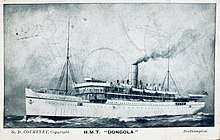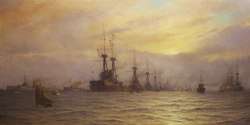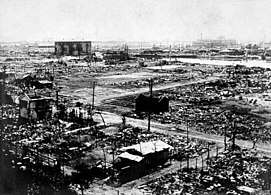SS Dongola
The SS Dongola, launched 14 September 1905, was a steam-powered passenger liner of the Peninsular and Oriental Steam Navigation Company, at various times used as a Royal Navy troop ship (HMT Dongola) and hospital ship (HMHS Dongola).
 Dongola about 1913 | |
| History | |
|---|---|
| Name: | SS Dongola / HMT Dongola |
| Namesake: | Dongola, a British victory in the Conquest of the Sudan on 21 September 1896[1][2] |
| Owner: |
|
| Operator: |
|
| Port of registry: |
|
| Builder: | Barclay Curle, Whiteinch, River Clyde |
| Cost: | £160,167 |
| Launched: | 14 September 1905 |
| Maiden voyage: | November 1905 |
| In service: | 15 November 1905 |
| Out of service: | 1926 |
| Homeport: | Southampton |
| Identification: |
|
| Fate: | Sold to T. W. Ward Ltd. for scrap in 1926 |
| General characteristics | |
| Class and type: | ocean liner |
| Tonnage: | |
| Length: | 470 feet (140 m) |
| Beam: | 56.2 feet (17.1 m) |
| Draught: | 27.7 feet (8.4 m) |
| Installed power: | 1,252 NHP |
| Speed: | 15.5 knots |
| Sensors and processing systems: | gyrocompass |
Except during the First World War, the ship's main use was as a passenger liner on the routes from England through the Suez Canal to India and the Far East, and she was fast enough to carry mail.
P & O sold the ship in June 1926 to be broken up for scrap.
Construction

Dongola was ordered by P & O from the shipbuilders Barclay, Curle and Co. of Whiteinch on the River Clyde, and work was reported to be in hand in March 1905.[3] She was one of four ships built in 1905 and 1906 called the "D" class, the others being Delhi, Devanha, and Delta.[4] The ship was launched on Thursday, 14 September 1905,[5] and named Dongola in memory of an Anglo-Egyptian victory on 21 September 1896 in the Anglo-Egyptian conquest of Sudan.[1]
The ship's dimensions were: length 470 feet; beam 56 feet 3 inches; draught 27 feet 8 inches; gross tonnage 8038; net tonnage 4723.[5] After trials and fitting out, she was delivered to her owners on 15 November 1905, at a price of £160,167,[6] equivalent to £17,325,804 in 2019.
Dongola had a twin-screw steam-powered quadruple-expansion engine, also built by Barclay, Curle and Co., generating 1,252 nominal horsepower and giving the ship a top speed of 15.5 knots.[5] As built, she had accommodation for 243 passengers, 163 in First Class cabins and 80 in Second Class, and had a cargo capacity of 13,189 cubic yards.[1]
The ship was designed to be crewed by 236 officers and men, 61 on deck, 91 in the engine room, and 84 in the purser's department.[1]
Early years

passenger on maiden voyage
In November 1905, P & O advertised "Direct China Sailings by new Twin Screw Mail Steamer Dongola", stopping in Egypt, Bombay, and Ceylon, with her final destination being Hong Kong.[7] On her maiden voyage beginning at the end of that year, the ship took Prince Arthur of Connaught and his party to China, on their way to Japan to invest the Emperor Meiji with the Order of the Garter.[6] The ship and the prince arrived in Hong Kong on 9 February 1906.[8] Dongola steamed across Hong Kong Harbour accompanied by a procession of gaily decorated launches, and the prince landed at Blake Pier, where there were speeches.[9]

Dongola took part
Having been designed as a seasonal troop ship, in July 1906 the ship was first taken up by the Admiralty on a summer trooping charter.[10] In 1907, she made a record speed from Southampton to Bombay, completing the voyage in eighteen days and seven hours. Seasonal trooping work was repeated every year until 1910, and in June 1911 the ship took part in King George V's Coronation Review of the Fleet, carrying Admiralty guests. Also in 1911, Dongola was used for Indian famine relief.[6]
Trooping charter work was repeated every summer from 1912 to 1914.[6]
Wartime hospital and troop ship
The ship was under charter and carrying troops when the British Empire declared war on Germany on 4 August 1914.[6]
.jpg)
At 10.47 pm on 4 March 1915, Dongola sailed from Avonmouth, and at 00.17 on 5 March she collided with the Belgian steamer Espagne, which was lying at anchor in the Bristol Channel. With a hole below the waterline, on the starboard side at the bow, Dongola was taking in water and was beached near Barry, South Wales, for the hole to be patched. At 4.48 am, the rising tide began to lift the ship, and she was winched into Barry Docks at about 8 am. On 17 March, she steamed back to sea, after repairs.[6]
In 1915, Dongola was requisitioned until further notice and served as a temporary hospital ship in the Dardanelles during the Gallipoli campaign of 1915 to 1916. She then returned to use as a troop transport, largely along the coast of East Africa.[6]
Baltic voyages
In 1919, Dongola remained requisitioned.[6]
The fighting with Germany had been ended by the Armistice of 11 November 1918, but throughout 1919 the Russian Civil War continued to rage, with some British (and Allied) intervention on behalf of the Whites. There was a state of undeclared war between Britain and the Bolsheviks, but in November 1919 Lloyd George began a process of coming to terms with the Soviet Union, and negotiations began in Copenhagen between the British and the Soviets. One of the issues was an exchange of prisoners and others wishing to return home, and an Agreement to this end was signed on 12 February 1920.[11]
Dongola was used to repatriate Russians from Great Britain to Reval in the Baltic, some of whom were being deported, and on 14 May 1920 she went on to Helsingfors in Finland to bring back people escaping from the Russian Civil War.[6] On 18 May, the ship arrived in Copenhagen, and the British press reported that she had on board 356 passengers released from Russia, some two hundred of them British subjects, including fifteen officers, together with 117 French civilians and 27 Danes.[12] The press was silent about several Russians also on board the ship.[13]
The ship arrived at Southampton on 22 May 1920. Those on board included the Rev. F. W. North, Anglican Chaplain in Moscow and his wife, the Russian jeweller Alexander Julius Fabergé, the eight-year-old half-British Dimitry Tolstoy, accompanied by his nurse, Lucy Stark, and Elijah Egmore, a butler. At Copenhagen, Dongola had taken on board several new passengers.[13]
Return to P & O
After her Baltic journeys, Dongola was returned to P & O and was refitted for commercial work. In October 1920 she made her first such voyage from the Port of London to Bombay.[6]
On 20 May 1922, the ship had a severe collision at speed in fog off Woosung, China with the Japanese ship Kumana Manu , whose officers were blamed for the incident. Dongola was beached but Kumana Maru continued her voyage. Both vessels had to go into dock for repairs.[6][14]
Earthquake at Yokohama
On 28 August 1923, Dongola arrived in Yokohama and was due to leave on 7 September.[15] On 1 September, she was anchored in the Inner Harbour when the Great Kanto earthquake occurred, which destroyed most of the city.[16]
Dongola's master Commander R. H. Griffin RNR, later reported to P & O in London:
At 11.55 a.m. ship commenced to tremble and vibrate violently and on looking towards the shore it was seen that a terrible earthquake was taking place, buildings were collapsing in all directions and in a few minutes nothing could be seen for clouds of dust. When these cleared away fire could be seen starting in many directions and in half an hour the whole city was in flames. The wind which had been force 5 at 11.0 a.m. rapidly increased to force 8, direction S.S.W., the smoke and heat blown directly over the ships in the harbour was intense.[1]

A large ship, the Lyons Maru, passed Dongola heading for open water and touched her bow plates, but did no damage. A burning lighter then hit the ship and sank, and about twelve of the crew were hauled on board, with another twelve drowning. By 5 p.m. the wind had died away and three boats were sent out to rescue survivors. They made several trips until after midnight, picking up more than 250 people, some badly injured. At daylight the boats were sent off again and more survivors rescued.[1]
By 9.40 a.m. on 2 September Griffin was worried by "large quantities of floating oil blazing furiously and drifting in various parts of the harbor", so he took his ship outside the breakwater. A steam launch then came out with more survivors. By 7 p.m. about 600 were on board, mainly Japanese, Russians, and Chinese. Some were transferred to other ships, and Dongola then steamed to Kobe with 505 passengers on board. One woman and one child died on the voyage and were buried at sea.[1]
The larger and newer Canadian Pacific liner RMS Empress of Australia had also been in Yokohama harbour at the time of the earthquake, and her captain recorded in the ship's log: "The vessel shook all over in a most terrifying fashion, and also rocked very quickly and violently until it seemed as though the masts and funnels must carry away." A long wharf beside the ship simply vanished. Empress of Australia also rescued many survivors.[17]
On 5 September, the British press reported that Dongola and all of her crew were safe and had taken aboard many injured and homeless.[15] On 28 December 1923, Commander Griffin was appointed OBE, and the master of the Empress of Australia, already an OBE, was promoted to CBE.[18] Griffin also received a Japanese decoration.[6]
Final years
.jpg)
In 1924, Dongola was providing a passenger service between Aden and Bombay, and in 1925 made a round trip from England to Australia and back.[6]
On 28 June 1926, P & O sold the ship to T. W. Ward Ltd. for demolition at Barrow-in-Furness, the price paid being £15,500.[6]
Notes
- Ship Fact Sheet Dongola (1905) at poheritage.com, accessed 9 May 2020
- Michael Lee Lanning, The Military 100: A Ranking of the Most Influential Military Leaders of all time, (Kensington Publishing, 2002), p. 478: "The advancing army met fierce resistance from the Arab defenders, but Kitchener's force gained victories at Dongola on September 21, 1896..."
- "GLASGOW AND THE CLYDE" in Lloyd's List (London, England), 9 March 1905, p. 3: "Barclay, Curle and Co. ... have built five vessels for the P. and 0. Company, and at present they have on hand the large twin-screw steamer Dongola for their eastern mail and passenger service."
- Boyd Cable, A Hundred Year History of the P. & O., Peninsular and Oriental Steam Navigation Company (London: Nicholson and Watson, 1937), p. 276; S. Swiggum, M. Kohli, Peninsular & Oriental Steam Navigation Company, The Ships' List at archive.org, accessed 22 May 2020
- Dongola at clydeships.co.uk, accessed 9 May 2020
- HMT Dongola at the-weatherings.co.uk, accessed 9 May 2020
- "P & 0. DIRECT CHINA SAILINGS BY NEW TWIN-SCREW MAIL STEAMER DONGOLA" in The Scotsman, 27 November 1905, p. 12
- "Prince Arthur arrived at Hong Kong on board the steamer Dongola" in Edinburgh Evening News , 10 February 1906, p. 5; "THE GARTER MISSION TO JAPAN" in The Scotsman (Midlothian), 10 February 1906, p. 9
- "Prince Arthur of Connaught arrived at Hong Kong" in Mid Sussex Times, 13 February 1906, p. 2
- "THE TROOPING SEASON" in Portsmouth Evening News, 23 July 1906, pp. 4–5: "Dongola... has been specially constructed for transferring troops, and belongs to the P. and O. Company."
- Nikolai Tolstoy, The Tolstoys (Hamish Hamilton, 1983), p. 338
- "BRITISH SUBJECTS RETURNING FROM RUSSIA" in Aberdeen Press and Journal, Tuesday 18 May 1920, p. 5: "The steamer Dongola arrived Copenhagen this morning from Finland with 356 persons on board, released from Russia. Those included the Rev. Mr North, British chaplain is Moscow."; "BACK FROM RUSSIA" in Belfast News-Letter, Tuesday 18 May 1920, p. 6: "... arrived this morning from Finland with 356 persons on board released from Russia, including Rev. Mr. North, British chaplain in Moscow, 15 British officers, and nearly 200 other British subjects, 117 French civilians, and 27 Danes."
- Dongola passenger list, 22 May 1920 at ancestry.co.uk, accessed 10 May 2020 (subscription required)
- "An Unlucky Coincidence. Dongola in Collision near Shanghai". The Times (43037). London. 22 May 1922. col E, p. 10.
- "Ship and all crew safe", in Lincolnshire Echo, 5 September 1923, p. 3: "Capt Griffin arrived in Yokohama Aug 28th. and was due to leave Sept. 7th. From the Press, Mrs Griffin has gleaned that after the earthquake the Dongola took aboard a large number of the injured and homeless."
- "A STEAMER'S RESCUE WORK AT YOKOHAMA. EARTHQUAKE SCENES. Captain R. H. Griffin, commanding the Steamship Dongola" in Yorkshire Post and Leeds Intelligencer, Thursday 4 October 1923, p. 4
- Anne Park Shannon, "Our History: Empress a witness to disaster" in Times Colonist, 8 March 2015, at timescolonist.com, accessed 10 May 2020
- The London Gazette, Issue 32892, 28 December 1923, p. 9105
External links
- Ship Fact Sheet Dongola (1905) at poheritage.com